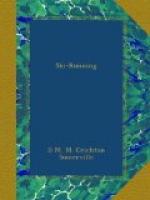On the top of ridges when the snow is blown away, all sorts of treasures may be recognized. The creeping azalea with its wee evergreen leaves, which no one, thinking of the garden azaleas at home, would recognize as belonging to the same family. Little primulas and saxifrages sheltering in cracks in the rocks, with nothing but bunches of brown leaves to show them up. Polygula Chamaebuxis or Bastard Box almost always in flower on a sunny patch even in midwinter. On the lower slopes, gentians or anemone plants with their buds waiting to open when the soft wind or rain of Spring calls to them. Erica carnea with its whitish buds waiting for Spring to colour them, one of the earliest of the flowers. Or the seeds of Gentiana lutea or asclepedia or purpurea and of Aconite or Monkshood on their strong stems standing high above the snow.
One winter when at 4,000 feet we had no snow at Christmas, we went flower hunting instead of Ski-ing, and found thirty different sorts of flowers out. But this was exceptional and by no means satisfying to the Ski runner, who has come out for the sport he loves and not on botany intent.
Later, when the snow begins to melt on South slopes in March, the mass of purple and white crocuses open to the sun; nothing in the whole world can equal the mass of these crocuses. They push up as the miracle of Spring, impatiently thrusting through the snow, melting holes for themselves. The soldanellas do the same, but not till late in March, and with them come gentians and the whole glory of the Alpine Spring has begun. By this time the Ski-er has to oil and put away his Skis or climb to the glaciers and higher snow fields. A wonderful experience alternating between Spring and Winter as he changes his levels.
SUMMER SKI-ING
The only experience of Summer Ski-ing which I have had is on the Jungfrau Joch, about 11,900 feet above the sea.
The Berner Oberland and Jungfrau Railways carry one up from Interlaken to the Joch where there is an excellent new hotel, offering every possible comfort.
Good Ski-ing can be had on the glaciers and I am surprised that more people do not come out for practice during the Summer.
The two great draw-backs to this Ski-ing are, firstly, the expense and, secondly, the difficulty of breathing. The expense is unavoidable because the carriage of building materials, food, etc. to such a height must necessarily entail high prices. Glacier Ski-ing, except on the snow-field near the Joch, also usually necessitates the employment of Guides. But these snow-fields are so extensive and so safe that a week could be spent in practising without a Guide.
After the first night on the Joch the feeling of breathlessness is reduced, and so long as all climbing is done slowly no bad effects need be expected by people in good health and condition. The Jungfrau Joch can be reached from London in twenty-six hours, and keen runners could enjoy a week or a fortnight of amusing Ski-ing on snow which lends itself particularly well to the practice of all turns.




